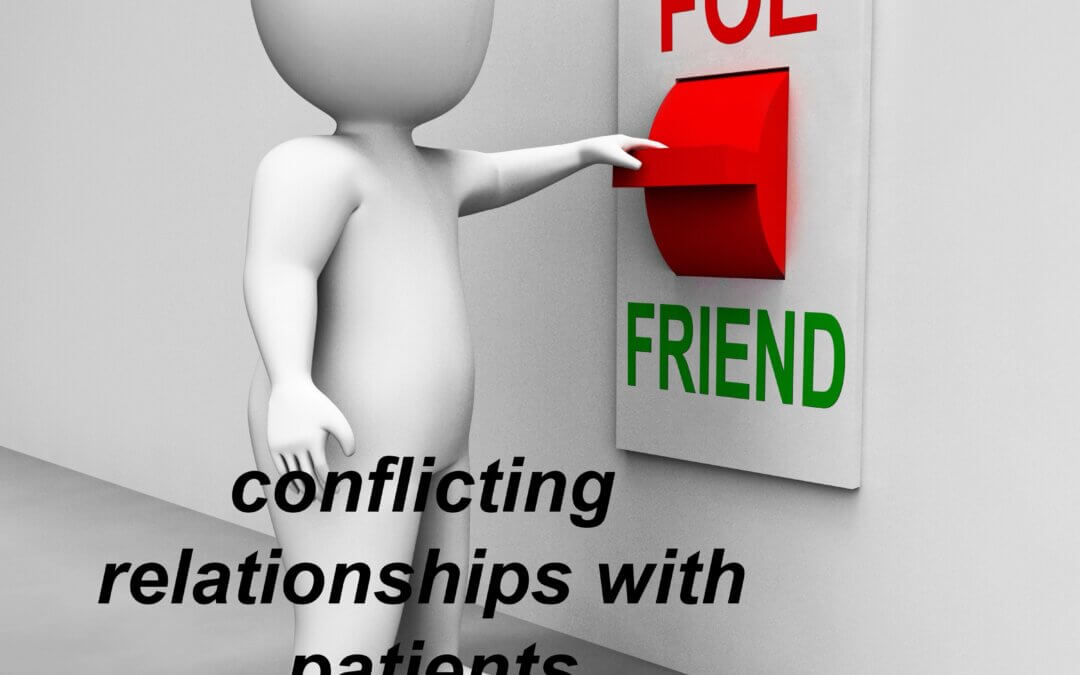How should you behave with patients?
My eye caught an article 29/9, which allowed my thoughts to drift into that old question. Gifts, jokes, religion, politics and sex. Ethically, professionally, and as a fundamental right to do what we feel is correct are important matters we must consider as clinicians. All these ideas will conflict if things go wrong. In this article, I will open this knotty topic with the help of an article from Medscape, which carries a parallel message about best practices. Medscape concerns itself with medical doctors in practice, while on this site, the focus remains podiatry.
The Professional Barrier
The title is probably more complex than meets the eye. Befriending and behaviour in practice become the narrative. I recall all too well a colleague being sued after his treatment failed to go to plan. He lost his case and said to me. ‘I don’t understand. She was so nice; she bought us chocolates and sent a nice, worded Christmas card.’ This reminds us of those sunny moments when a black cloud appears, and rain and thunder descend. The brain is confused emotionally as one minute, all is well, and then the volcano erupts.
A visiting clinical tutor provided well-considered thoughts on attending a party and giving professional advice. If someone asks for advice during such an occasion when you are socialising, give them your business card and suggest they make an appointment when convenient! Maybe I thought it was stuffy but later considered that the tutor was ensuring the professional barrier was in place.
Casual chitchat leads to the realisation that you and the patient share a similar interest, and before long, you’re more than the clinician-patient. As reported in Medscape’s 2022 Physician Friendships: The Joys and Challenges surveyed nearly 1600 doctors on various aspects of friendships. When questioned about doctor-patient friendships, 29% of respondents said that they do indeed make friends with their patients. It is quite likely that podiatrists foster similar trends.
Building Trust
It is likely that podiatrists or others reading this article feel it is essential to bond and create a sense of trust through light-hearted banter. Perhaps we think we are better liked and can outclass an old practitioner who hardly breaks a smile. It would be unusual for any self-respective clinician to be unaware of the subject of body language, but non-verbal cues are essential. A smile never hurts, but it is listening that is vital. Listen before speaking and acting. Listen before giving an opinion. Ask the patient’s viewpoint; what do they believe the problem is, and what would they like to achieve?
Giving out personal numbers was something I never bought into. I had a network which allowed patients to contact my office hospital, and then I would be contacted if it was urgent. I agree with Dr Tano; maybe children need a little more management, but still, as long as a contact number can reach the helpline, no more needs to be done. Treatment that causes pain and infection risk and needs rehabilitation is essential to ensure support. I had an emergency number for my dental prosthetist as the dry socket was a big worry. I called him for reassurance and left a message, but no one returned my call, despite the significant cost incurred for my private care. Geoff liked to be called by his first name, joked a lot and kept touching my shoulder between discussions. I might have read all this differently if I had not been a clinician.
Rules of the road
There are no laws preventing patient friendships, yet most professional bodies frown on such connections. Clinicians generally should not treat themselves or members of their immediate families. It is the objectivity behind the association that is at risk.
Dr McLean sees clinician-patient friendships in black-and-white terms. She suggests that ‘friendships are really not a good idea,’ because the primary obligation is to do no harm. Unintentional harm can arise, of course, because we are not as thorough, and we might cut corners in a genuine desire to help without a whole gamut of diagnostics.
Many people will give advice, as indeed I experience even in retirement. You will have read about some on my site, but each is tempered with seeking help from a GP, a podiatrist or a surgeon. I don’t actually treat. Friends naturally will come to colleagues as they trust them, but this article’s point is to ensure there are boundaries. Intimate friends could speak inappropriately about advice. ‘He or she said I should lose weight, stop smoking, stop drinking as much, have you seen them? They smoke like a trooper, drink like a fish and eat like there’s no tomorrow!’
When examining patients, and I don’t mean feet, you must be careful; this is where a chaperone is essential. Today it would matter little which gender was involved because the vulnerability remains based on what she or he said and what I said. An investigation might lead to an exoneration, but the taint remains only to be rekindled. I have made a point of never speaking to my partner about friends I have managed professionally. I even concern myself with not talking to a patient’s partner about their condition without permission.
Forty years ago, I befriended my optometrist, and we played squash together, but there were no other boundaries breached and in some ways being professionals eased any concerns. But I remind myself these were different times, and I was on the better side of 25 years old. Youth seems to be more easygoing.
Personal information
It was not until I became involved with the cruel pain syndrome – complex regional pain syndrome – that I realised pain could incite an orgasm. Fresh from a conference offering this revelation from the Bristol Pain Centre and their lead professor at the time, I ask the question in front of the patient’s husband. Both of us were shocked to learn she had painful clitoral orgasms. So much for dealing with feet! Delivering bad news is never easy, and I learned how to talk about cancerous changes to patients. I would not want to do this with someone close to me, as the level of objectivity is vital in ensuring the best pathway is followed.
Language barriers
I feel that much of our role is to interpret complex medical jargon. ‘While many doctors prefer to avoid practising medicine on friends, there are ways your skill set can help them, all while staying on the safe side of ethics. One is helping to interpret medicalese,’ says McLean. ‘Most of us don’t talk that language,’ she says. ‘So serve as an interpreter for your friends, helping them understand the alphabet soup they’re facing.’ (Medscape, 2022)
Wendy was a patient who contacted me through my website Consultingfootpain.co.uk – ‘Do you mind if I ask one question?’ She asked me to interpret a radiographer’s report. ‘Please, can you make any translation of it for me as it’s tricky for me?’
A few thoughts on behaviour
- Avoid talking about yourself, although empathy is a valid tool.
- Don’t meet patients outside the office except as part of management.
- Consider friends and colleagues as you would patients and agree on boundaries.
- Avoid jokes and make judgemental comments about any fellow practitioner.
- If you wish to become involved with a patient, consider discharging them from your care before commencing a close and intimate relationship.
I might have started with my colleague’s disgust at being sued after receiving gifts which were more in the spirit of the season of Yule Tide. In my own case, hearing a patient tell the court about my own behaviour made me realise that even the most innocuous comment is used to cause harm. None of us is perfect but navigating today’s healthcare system is complex.
As McLean says – ‘All patients deserve equal access to treatment.’ As for Wendy – my in-box recorded the following –
‘ I’m very grateful to you for your kind, supportive and informative replies. Thank you so much. I wish to find someone as professional and caring for other areas of health problems I’d like answering too.’
Thanks for reading ‘Should you befriend patients?’
David is a retired consultant podiatric surgeon and now author-journalist. You can read more articles on his site or go to ABOUT.
Published by Busypencilcase Communications Est. 2015



Trackbacks/Pingbacks